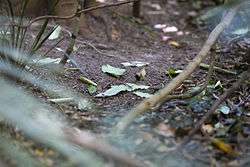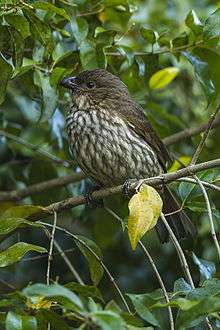Tooth-billed bowerbird
The tooth-billed bowerbird (Scenopoeetes dentirostris) also known as stagemaker bowerbird and tooth-billed catbird is a medium-sized, approximately 27 centimetres (11 in) long, stocky olive-brown bowerbird with brown-streaked buffish white below, grey feet, brown iris and unique tooth-like bill.[2][3][4] Both sexes are similar, however the female is slightly smaller than the male. It is the only member in monotypic genus Scenopoeetes.

| Tooth-billed bowerbird | |
|---|---|
 | |
| Scientific classification | |
| Kingdom: | Animalia |
| Phylum: | Chordata |
| Class: | Aves |
| Order: | Passeriformes |
| Family: | Ptilonorhynchidae |
| Genus: | Scenopoeetes Coues, 1891 |
| Species: | S. dentirostris |
| Binomial name | |
| Scenopoeetes dentirostris (Ramsay, 1876) | |
An Australian endemic, the tooth-billed bowerbird is distributed to mountain forests of northeast Queensland.[5] Its diet consists mainly of fruits and young leaves of forest trees.
The male is polygamous and builds a display-court or "stage-type bower", decorated with fresh green leaves laid with pale underside uppermost.[6] The leaves are collected by the male by chewing through the leaf stalk and old leaves are removed from the display-court. The display-court consists of a cleared area containing at least one tree trunk used by the male for perching. Upon the approach of a female the male drops to the ground and displays.
A common species in its limited habitat range, the tooth-billed bowerbird is evaluated as least concern on the IUCN Red List of Threatened Species.[1]
Notes
- BirdLife International (2012). "Scenopoeetes dentirostris". IUCN Red List of Threatened Species. 2012. Retrieved 26 November 2013.CS1 maint: ref=harv (link)
- "Scenopoeetes dentirostris". Australian Antarctic Data Centre. Department of Sustainability, Environment, Water, Population and Community. Retrieved 28 June 2012.
- Marshall, Jock (1954). Bower-birds, their displays and breeding cycles : a preliminary statement. Clarendon Press. p. 154.
- Hutchinson, G. Evelyn (1970). The itinerant ivory tower; scientific and literary essays. Freeport, N.Y.: Books for Libraries Press. pp. 56–59. ISBN 083691712X.
- "Tooth-billed Bowerbird (Scenopoeetes dentirostris)". BirdLife International. Retrieved 28 June 2012.
- Rowland, Peter (2008). Bowerbirds. Collingwood, Vic.: CSIRO Pub. p. 22. ISBN 9780643094208.
References
- Pizzey, G and Knight, F. (1997). "The Field Guide to Birds of Australia". Angus and Robertson. Sydney.
